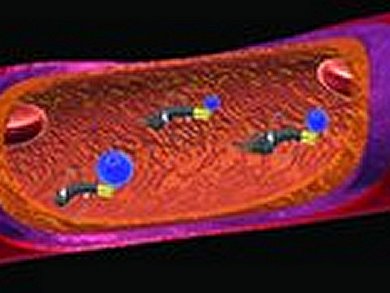Catalytic nanowire motors are of interest for biomedical applications including drug delivery and gene therapy due to their ability to pick up, tow, and release particles. For example, Joseph Wang and co-workers, University of California, San Diego, USA, recently demonstrated the guided transport of drug-loaded liposomes, pancreatic cancer cells, and nucleic acids by fuel-driven nanomotors. Despite the advances in cargo-towing by catalytic nanomotors, future ex-vivo and in-vivo biomedical transport applications require the use of biocompatible, fuel-free nanomotors.
Wang and co-workers now report magnetically driven (fuel-free) nanomotors. These two- or three-segment, flexible nanowire motors consist of a rotating magnetic nickel head (≈ 1.5 μm long), along with a flexible silver segment (≈ 4 μm long). They are able to pick-up and transport various drug carriers from a loading zone to a predetermined destination through a predefined route. The transport occurs at a rate order of magnitude faster than that expected from Brownian motion and they are among the fastest fuel-free synthetic nanomotors reported to date.
Image: © Wiley-VCH
- Cargo-Towing Fuel-Free Magnetic Nanoswimmers for Targeted Drug Delivery
W. Gao, D. Kagan, O. S. Pak, C. Clawson, S. Campuzano, E. Chuluun-Erdene, E. Shipton, E. E. Fullerton, L. Zhang, E. Lauga, J. Wang,
Small 2011.
DOI: 10.1002/smll.201101909



